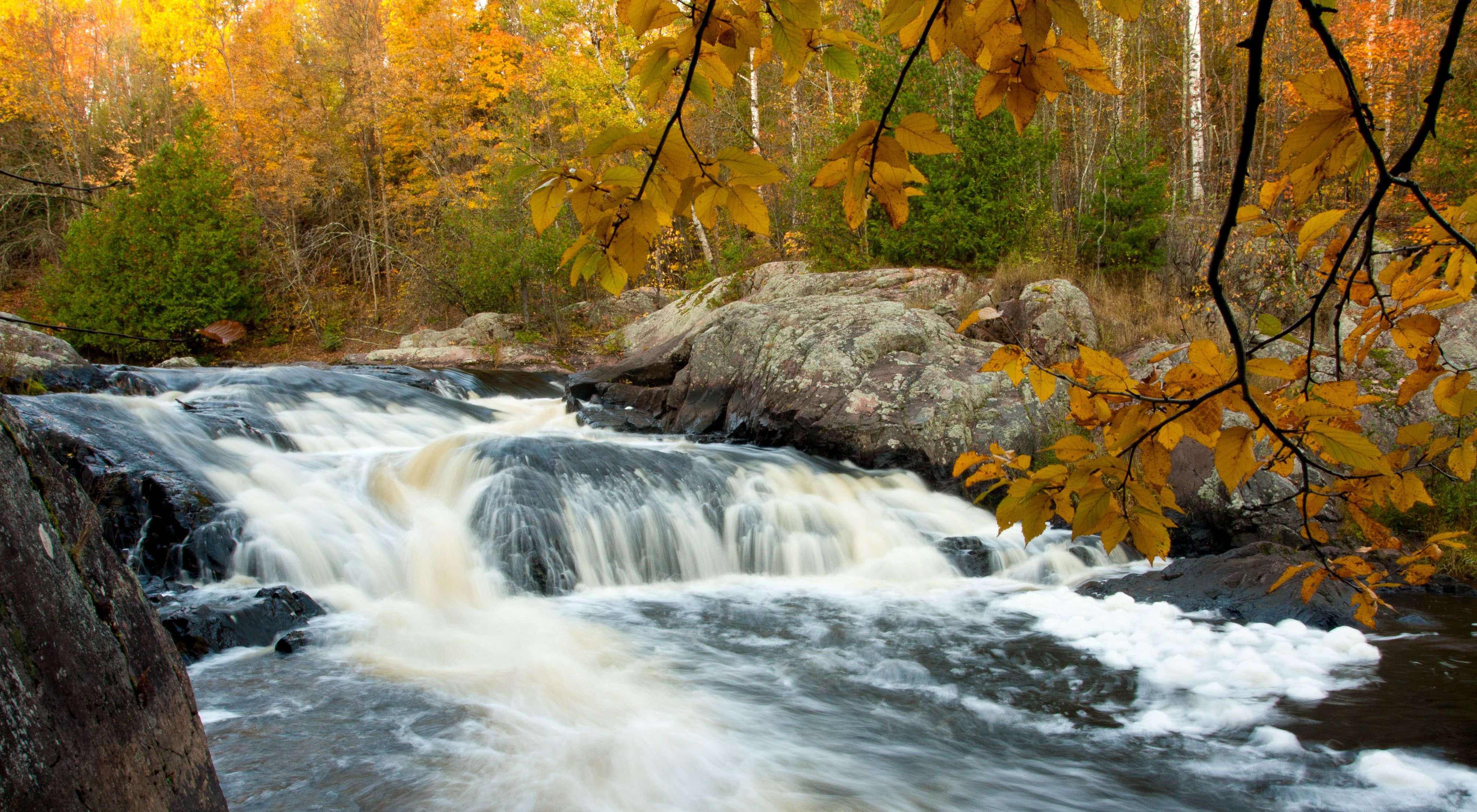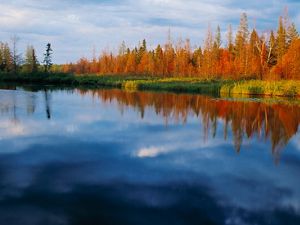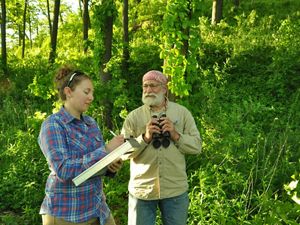Shaping Future Forests at Caroline Lake
We adapted our forest management at Caroline Lake Preserve to keep these Great Lakes forests healthy and productive in the face of climate change.
Keep up with nature in Wisconsin!
Sign up to get our monthly Nature News email.
Home to migratory warblers, wolves and the rare pine marten, the Caroline Lake Preserve in Iron County is a great place to experience the serenity and beauty of the forests and wild lakes that epitomize Wisconsin’s Northwoods.
The forests at Caroline Lake are located in the Great Lakes basin. They are part of the Northwoods in the upper Midwest that comprise one of the largest remaining swaths of unbroken hardwood forest in the United States.
Like other Northwoods forests, the forests at the Caroline Lake Preserve face an uncertain future due to an increasing trend toward hotter, drier summers, unpredictable storm events and milder winters.
We caught up with Matt Dallman, Wisconsin deputy state director, to see how The Nature Conservancy (TNC) is changing its forest management at Caroline Lake Preserve to help keep the forests healthy and productive for generations to come as conditions change in the Northwoods.
Quote: Matt Dallman

Our goal is to create a more diverse forest in terms of tree species, age and structure, because a more diverse forest will be more resilient to changing conditions, including climate.
TNC:
Tell us about the Caroline Lake Preserve. Why is it special?
MATT DALLMAN:
Despite the logging in Wisconsin’s Northwoods from the late 1800s to the 1930s, the forest at Caroline Lake Preserve still has all the tree species it once did—hemlock, sugar maple, white pine and white cedars, to name a few. But the forest has changed. The larger and older trees are missing, and the way the tree species are distributed across the forest is different. There is also an increasing abundance of red oak on the property.
The forest provides important habitat for a diversity of birds, especially neotropical migrants like the black-throated blue warbler, northern parula and Canada warbler.
And perhaps, most importantly, the Bad River starts at Caroline Lake Preserve. The forest on the property serves as a filter, providing clean, clear water that contributes to the high water quality of the Kakagon and Bad River Sloughs—16,000 acres of wetlands, streams and open water along the southern shore of Lake Superior. Wild rice, which provides physical and spiritual sustenance to the Ojibwe people, still grows abundantly in the sloughs.
TNC:
What are climate scientists telling us the future might look like in the Northwoods?
MATT DALLMAN:
The Wisconsin Initiative on Climate Change Impacts (WICCI), which has done extensive research to understand how Wisconsin’s climate has already changed and how it may continue to change in the future, anticipates an increasing trend toward warmer summers, more severe and unpredictable weather and milder winters in the Northwoods.
Warmer temperatures in winter could mean less snow depth and duration, leading to increased potential for deer browsing on vegetation. Conditions in the future could be less hospitable to some tree species, like aspen, paper birch, black spruce and balsam fir, while favoring others like red oak.

TNC:
So, are you saying there could be winners and losers as the climate changes in northern Wisconsin?
MATT DALLMAN:
We think it’s likely that some tree species will fare better in the future than others—red oaks, for example. Right now, they occur at a low abundance and are scattered throughout the Caroline Lake Preserve. In a future with warmer year-round temperatures and the longer dry periods projected for summer, they could become a more dominant part of the forest, while the populations of other species like sugar maple, yellow birch and aspen—which dominate the forest today—could decline.
Another example is the rare pine marten, which needs good snow cover to survive. In the future, if there is more rain than snow, which is possible, then the fisher (another member of the weasel family that directly competes with pine martens) could gain a competitive edge, and we could lose the recovering pine marten population in northern Wisconsin.
TNC:
What is TNC doing to help the forests at Caroline Lake Preserve adapt to climate change?
MATT DALLMAN:
We have worked with the U.S. Forest Service’s Northern Institute of Applied Climate Science (NIACS), the Wisconsin Department of Natural Resources and other partners to use the best available climate science to modify our forest management at Caroline Lake Preserve in a way that we believe will help keep the forests healthy and productive in the anticipated warmer, less predictable future.
Our goal is to create a more diverse forest in terms of tree species, age and structure, because a diverse forest will be more resilient to a changing climate. So, we’re not just managing for a few desirable tree species—young or old trees, big or little trees—but a mix of all types. We will continue to manage for the hemlock and yellow birch that characterize this northern hemlock-hardwood forest, but we’ll also manage for species like red oak, which science suggests will do better in a warmer future.

TNC:
What have you done so far?
MATT DALLMAN:
Using a detailed forest inventory and a computer model to evaluate the risks the forest could face in the future under different climate scenarios, we generated a variety of management actions to enhance forest resilience under a wide range of future climate conditions.
With our forest consultant, we have integrated a set of selected management actions and are using those to guide our forest stand level management. The management actions we are taking vary in different parts of the forest, and in some places we are choosing to take no action.
For example, typical standard management in a northern hardwoods forest focuses on removing the poorest quality trees in the stand. This usually entails removing single trees, leaving a mostly shaded forest. As we look to promote a diversity of tree species and especially oak, climate-informed forestry suggests we create larger gaps in the forest canopy, increasing sunlight to the forest floor and benefiting species that thrive in full sun.
TNC:
How will TNC know if it is successful, and how long will it take?
MATT DALLMAN:
Before we started this process, we gathered baseline data on the composition and condition of the forest. We have also established permanent forest inventory plots so we can monitor change over time and evaluate if we are achieving our goals.
Change won’t happen quickly because trees grow on generational time frames, not human time. We’re not taking drastic steps; we are using traditional forestry methods but looking 50 to 100 years ahead so we can slowly move the forest at Caroline Lake Preserve from its current composition to one that science suggests can withstand a range of potential future conditions from warm and dry to periods of being inundated by intense rain events.
Protecting the Northwoods
The Caroline Lake Preserve is part of the Great Lakes Northwoods, which contain some of the most resilient and connected landscapes in the central U.S. This area features a range of habitats and topographies that allow plants and animals to find the habitat they need in a changing climate.





Caroline Lake Preserve: The Bad River has its beginning at Caroline Lake. © Robert A. Kleppin

Northern Parula: The forest at Caroline Lake Preserve provides important habitat for a diversity of birds, especially neotropical migrants like the northern parula. © TNC

Shore of Caroline Lake: The Caroline Lake Preserve is a great place to experience the serenity and beauty of the wild, undeveloped lakes that epitomize Wisconsin's Northwoods. © Robert A. Kleppin

Gray Wolf: The Northwoods provide critical habitats for diverse plant and wildlife, including the gray wolf. © Robert A. Kleppin
TNC:
Will the work TNC is doing at Caroline Lake Preserve be used elsewhere?
MATT DALLMAN:
Our Caroline Lake project is part of a larger effort to help forest managers access current information on forest vulnerability related to climate change and use it to meet their specific, on-the-ground forest management needs. Caroline Lake Preserve is one of several demonstration projects that provide real-world examples for forest managers of how climate change information has been integrated into forest management. You can find a summary of the Caroline Lake adaptation demonstration project on the NIACS Climate Change Response Framework website.
We are sharing our learning from managing the forests at Caroline Lake Preserve in a variety of ways with forest managers in Wisconsin, the Great Lakes region and beyond. One of the most impactful ways is having TNC staff continue to be active participants in the WICCI Forestry Working Group. This group is now serving as a conduit to share the latest forest climate science with forest practitioners.



